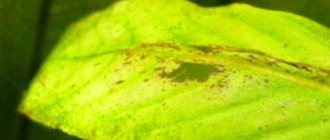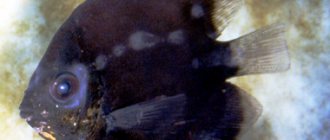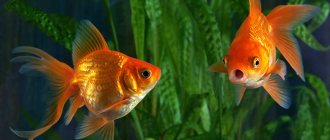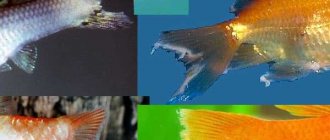Appearance
Red parrots have an unusual body; their colorful colors attract the attention of adults and children. The body is slightly flattened, and the chubby cheeks look quite cute.
The head is a bit like the beak of a parrot bird, which is why these pets were given this name. Grows up to 25-30 cm.
Nature has endowed the parrotfish with various colors; they come in several colors. White fish are often bred. Scientists still don’t understand whether this is a natural color or an albino cichlid.
You can expect adults to grow up to 8 inches long, with a round body, large fins, large eyes and a beak-like mouth.
These are beautiful fish with a bright orange color that rivals the brightest fish in the world.
The color may be continuous throughout the body, but more often it is interrupted by patches of a different color (usually white). Other colors have been developed, including red and yellow.
Dyes are often used to produce more color options, but this shortens the lifespan of the fish.
Males and females are very similar, but males are slightly larger. Hybridization has caused the parrots to develop a genetic defect that prevents their mouths from closing completely. As a result, the teeth end up in the throat, which they squeeze to crush the food.
These fish have an unusual property - they change their color under stress and danger. Then the parrots instantly lose all their bright, attractive color.
Most often, aquarists breed red parrots. It can never be seen in nature. The red color was developed by breeders.
The riot and variety of colors - blue, red, violet, yellow, blue, green - were obtained through special dyeing. It must be remembered that due to staining they have a weakened immune system and require more attentive care.
Tattooed fish are in great demand among connoisseurs. They have a tattoo on their torso. It must be remembered that these exotic specimens do not live very long. The fish often appears to glow with a bright, dark red light. These fish are often called "purple parrots". They are either impregnated with paint or treated with hormones to enhance color, which has a negative impact on health.
The demand of aquarists for such fish motivates specialists to distort the body of defenseless creatures.
Red fish are distinguished by several external factors: the shape of the body and fins.
There are quite unusual and even exotic species:
- love heart - has no tail, the body looks like a valentine or a heart;
- unicorn - distinguished by a large growth on the head;
- King Kong is a rather large fish with a huge tubercle in the middle of its forehead;
- red fortune - has elongated fins, a large growth on the head;
- red ingot - has a disc-shaped flattened body.
Because this is a relatively new hybrid, it does not have a Latin or scientific name, so the fish are sometimes simply called parrot cichlids.
This species was bred as a hybrid of two other species.
Many people like these cichlids. They are unpretentious, have attractive colors and look original. Photo.
The red parrot was bred by Taiwanese breeders quite recently. It is unpretentious and disease resistant.
What it looks like and where it lives
The parrot fish appeared thanks to the work of Taiwanese breeders, and is a triple hybrid. The most likely candidates for the parrot's ancestors are predicted to be:
- citron and rainbow cichlases;
- cichlasom severatum and labiatum;
- cichlase severatum, labiatum and fenestratum.
Unfortunately, it is not possible to more accurately identify the predecessor fish; the creators carefully guard the secret of creating the incredible fish.
Description
The parrot's body is dense, round, and most closely resembles a barrel. The mouth is small and, due to its specific structure, does not close completely.
In an aquarium, with proper care, the body size of the fish can reach 30 cm, but more often the parrot is somewhat smaller.
In the sea, in the area of coral reefs, divers love to watch the namesake parrot. The body length of the sea fish exceeds a meter, and in adult form it reaches 130 cm, the weight of the fish is about 40 kg. This is a green cone-faced parrot fish.
In real life, it will not be possible to meet relatives of the red parrot, since the fish was bred artificially.
The efforts of the creators led to the fact that the body of the fish is severely deformed, so the internal organs are noticeably displaced, the spine is arched.
Such modifications could not but affect the movements of the parrot; the fish swims somewhat awkwardly.
The fins of the parrot are smooth, but there are modifications with very long caudal fins, similar to a veil, or even with a complete absence of a tail.
Features of behavior
Parrots are peaceful and quickly become attached to their owner . They often swim up to the wall of the reservoir, examining the breadwinner through the glass.
An exception to the general rule are males during the spawning period: they show increased nervousness and can demonstrate aggression towards neighbors swimming into their territory.
How long does a parrot fish live?
The average lifespan of a parrot fish in an aquarium is 7 years , but if you create comfortable living conditions and the right diet, the fish can easily live 8–9 or even 10 years.
Keeping in an aquarium
These amazing colorful and cheerful aquarium inhabitants are very active all day long. They constantly chase each other throughout the free space, so they are very much appreciated by aquarists.
Therefore, for parrots to spend their time comfortably, it is necessary to have a sufficiently large aquarium of 200 liters or more. These fish must have freedom of movement. They spend most of their time at the middle levels of the tank, but sometimes they go lower and start digging in search of food.
As they eat, they will leave behind a mess that will require additional cleanup.
A balance needs to be found between open swimming areas and isolated shelters.
They need both because although they usually swim around the tank, they also often get scared and try to avoid stressful situations.
You can place rocks, branches or pottery shards around the lower levels of the aquarium to leave open water on top.
Also use a lot of plants. This is another great form of cover. There are many species to choose from: Java fern, Anubias nana or hornwort.
You can use a sandy substrate. These fish tend to dig, so rough substrate can scratch them, leading to cuts and infections.
Caring for a parrot is not difficult, but you need to know a few secrets of keeping these cheerful, bright and slightly mysterious pets.
What treatment options are there?
To begin with, it is recommended to contact specialists. Only they will be able to accurately and quickly make the correct diagnosis and prescribe adequate therapy.
If it is an infection, you will definitely need an antibiotic. As well as anti-inflammatory drugs, drugs that increase immunity, it is possible to prescribe homeopathic drugs. The duration of taking medications and their dosage will also be prescribed by the treating specialist.
If it comes to non-contagious pathologies, then it is necessary to establish the source of the disease, eliminate it, and then begin treatment of the accompanying symptoms, which will alleviate the general condition.
The main reason is poisoning; adsorbent agents and enzymes (activated carbon, Smecta) are recommended for use. To restore intestinal flora - “Linex”. For bleeding, use the hemostatic agent “Ditsinon”, a decoction of nettle and chamomile. For kidney infections - Vitasol.
When infected with ectoparasites, Aversectin ointment is effective, as well as “Insektol” and “Clandestine” sprays.
Colds and acute respiratory viral infections should be treated by heating, drinking herbal decoctions, and children's syrups.
During the treatment period, it is also important to monitor proper nutrition, its variety, and, if necessary, add vitamin supplements. Follow all doctor's instructions, pay attention to your pet's reaction to the administration of medications, so as not to miss the development of allergies and edema.
And, most importantly, remember that any disease is easier to prevent than to treat, everything here is the same as in people. Take care of your birds and they will respond to you with kindness and affection!
Macaw parrot: DESCRIPTION, PHOTO, CARE, CONTENT, FOOD
PARROT AMAZON: DESCRIPTION, PHOTO, CARE, CONTENTS, LIFESTYLE
COCKATOO: PHOTOS, CARE AND MAINTENANCE AT HOME, DESCRIPTION
Lovebirds: DESCRIPTION, PHOTO, CARE, CONTENT, FEEDING
What to feed
In matters of nutrition, these amazing, cheerful fish are generally unpretentious, have a good appetite, but cannot be overfed.
The diet of parrots should include both live and dry food. They love bloodworms, tubifex, and small shrimp. Adult fish often lose their color. In this case, you can add more shrimp and carotene to the water.
It is strictly not recommended to overfeed your pets; you need to accustom them to feeding them three times a day in small portions.
Feeding
Fish of this species have a very small mouth, which opens at a small angle and vertically. Therefore, there may be some difficulties with feeding fish, especially if you do not know the specifics of their structure. However, this problem can be solved. Stores sell special granulated food, the granules of which are small, which allows the fish to grab them without much difficulty. These small fish are extremely voracious and can feed on various types of food. They love dry food, but they won’t pass by chopped fish or shrimp. It will also be beneficial for them to eat food of plant origin, such as green peas, zucchini, red pepper plays a special role, since the carotene it contains enhances the brightness of the color.
It is worth giving food to the fish twice a day, in small dosages. You need to feed in the evening several hours before the lights turn off in the fish’s “house”. It is also necessary to ensure that the fish eat all the food, otherwise the fish will eat the remains of it in the morning and may be poisoned by it.
Aquarium equipment
Parrots love running, flowing water. Therefore, the aquarium must have special equipment for aeration and simulating water flows. Then the kids will feel comfortable and freely frolic in the streams of water.
The equipment set must include the following required elements:
- Special pump for simulating underwater flows.
- Aeration equipment.
- There must be a lid for the aquarium so that moving fish do not jump out.
- Parrots do not need excessive decoration; they love space and clean water.
Only if the listed requirements are met, the health of the parrot fish will be at a high level.
Listeriosis in parrots
Listeriosis, the causative agent is the motile, non-spore-forming gram-positive bacillus Listeria monocytogenes , a saprozoonotic infectious disease that mainly affects newborns, pregnant women and immunosuppressed individuals. It is distinguished by clinical polymorphism with manifestations ranging from latent infection to severe damage to the nervous system and sepsis.
People's natural susceptibility is low. Diseases occur most often in the elderly, newborns, and in people with immunodeficiencies.
You will also have to decide whether to wait for your parrot to die naturally or resort to euthanasia if your parrot has one of the following diseases.
Compatibility with other fish
Colorful bright fish get along well with other species, even with predatory catfish, barbs and arowana. Therefore, the aquarium can be filled to capacity. To fill out the lower levels, consider keeping yoyo loaches, corridor catfish, or clown loaches.
Invertebrates should be avoided as they can be eaten. However, if you want to give it a try, you can keep the apple snails because they have a particularly hard shell.
When choosing the best neighbors for your parrot, pay attention to the most attractive aquarium fish.
Parasites
Considering what diseases there are in budgies, symptoms and treatment, one cannot ignore the topic of parasites. Parrots sometimes become victims of internal or external parasites. Some of them are easy to spot when interacting with the bird. Other parasites become noticeable only after their presence begins to greatly affect the condition of the bird. For example, the owner will have no problem noticing that the pet is losing its feathers. Someone may live in a bird's intestines. In this case, to determine the presence of parasites, you need to notice the accompanying symptoms.
Sex differences
For most of cichlid history, they were thought to be completely sterile. But then there were reports that parrots were laying eggs.
Typically, cichlids with long, pointed fins are males, while females have shorter, rounded fins. Males also show brighter colors. For high-quality reproduction of red fish, you need to create favorable conditions. They can spawn in a community aquarium, but the volume must be large. It is also necessary to provide live food in the diet.
Usually the female gives the initiative for mating. With all her appearance, behavior and the play of her bright colors, she makes it clear to the male that there will be mating and procreation. In an aquarium, this whole love process can have a bad effect on other fish. This happens because the female parakeet behaves very aggressively during spawning and can viciously attack fish.
First, a couple in love prepares a shelter for their future offspring. They carefully clean the prepared burrow from dirt and debris. And only after a general cleaning of the home will there be eggs in a clean nest. The volume of eggs in one litter can reach up to 300 pieces.
Until the fry hatch from the eggs, dad and mom fiercely guard them, they will attack everyone who approaches the spawning with eggs. The timing of the birth of babies depends on the water temperature. At 29 degrees, spawning will occur in 7-8 days. The fry immediately swim fully. Baby parrots are born dark and remain invisible in the water for a long time.
From birth, their parents teach babies to hide in a shelter. Parrots grow to adulthood within a month.
Salmonellosis in parrots
Salmonellosis is an acute intestinal infection of animals and humans caused by salmonella (lat. Salmonella - a genus of non-spore-bearing bacteria). Salmonella, having entered the intestine with food and water, multiply in the small intestine, colonize the large intestine, penetrate into solitary follicles and Peyer's patches, as well as mesenteric lymphatics nodes from which they enter the blood. Inflammation develops in places of reproduction (intestinal mucosa, gall bladder, liver), which leads to subsequent necrosis.
After a short incubation period (3-4 days), the sick bird develops lethargy, depression, fever, and intestinal upset. Often, during an acute infection, blueness of the beak and paws occurs, which indicates sepsis. The stools are liquid, orange-green in color, sometimes with blood. In subacute and chronic cases, yellowness of the mucous membranes, exhaustion of the bird, and sometimes vitelline peritonitis are noted. Possible damage to the lungs, joints, brain, uterus and fetus. Death occurs from dehydration, numerous hemorrhages, intoxication and sepsis.
In the subacute course, clinical signs are not expressed and occur in the form of depression, apathy, arthritis, intestinal disorders, and conjunctivitis. Sometimes paralysis of the wings and legs occurs.
Salmonella is one of the main causative agents of severe foodborne toxic infections in humans. The incubation period is from 2-6 hours to 2-3 days, usually 12-24 hours. The onset is acute. With the gastrointestinal form, chills, headache and muscle pain, tachycardia appear, and the temperature rises to 38-39 ° C or more. At the same time, pain occurs in the epi- and mesogastrium, nausea, repeated vomiting, and frequent watery, foul-smelling stools with greens. Dehydration, convulsions, and arterial hypotension are possible.
Possible diseases
Parrot fish are very resistant to infections and diseases. They very rarely get sick. Aquarists need to be well aware of the symptoms of various diseases, then they can quickly help their pets recover.
Signs of diseases in parrots:
- Spots on the body. Often this color change is caused by a high concentration of nitrates in the water. You need to check the water or immediately clean it using a special siphon. Then you need to replace the water with clean water.
- The fish sink to the bottom, do not play and move slowly. The water urgently needs to be treated with “methylene blue”; it will turn blue. You can also add 1/2 tablet of Kanamycin or Metronidazole. The medications will have to be added for at least a week. You will have to change the water every day and constantly add the indicated medications.
- A dangerous disease in parrots is ichthyophthyriosis. It is distinguished by the appearance of whitish grains on the body, similar to semolina. This can only be cured by using Sera costapur medicinal products. When treating, the light in the aquarium must be turned off, otherwise the medicine will not work. Replacing and cleaning water in an aquarium with sick fish is an important point.
- If you correctly follow all the recommendations of specialists for the treatment and care of aquarium pets, then after 5-7 days the rashes will begin to disappear and the parrots will again delight their owners with cheerful fuss and games.
Keeping playful colorful parrot fish is practically no different from caring for other aquarium fish. But the bright colored inhabitants are pleasing to the eye, and their endless games are so fun to watch while relaxing in a cozy home environment.
Reproduction
Breeding parrotfish at home in an aquarium is impossible. Males of this representative of cichlids are sterile and spawning is impossible. In the second year of life, pairs form, nests are dug, and eggs are laid. A couple of days later she dies. Fertilizes the eggs of the female of other cichlids. Then the offspring from breeding differ in appearance from parrots.
Sex differences
Distinctive features of males and females appear during the spawning period, when they reach the age of 1.5 years. In females, a pear-shaped tubercle is formed in the tail area, and in males, a cone-shaped tubercle is formed.
Respiratory mycoplasmosis in parrots
Respiratory mycoplasmosis is a chronic contiguous infectious disease that affects the respiratory system of birds. The causative agent of the disease is Mycoplasma gallisepticum, a microorganism that is weakly resistant in the external environment. As a rule, respiratory mycoplasmosis in most cases is complicated by colibacillosis, salmonellosis, and various staphyloccal infections. Budgerigars and cockatiels are mainly susceptible to this disease.
Infection occurs by airborne droplets and is also transmitted to offspring through infected eggs. A sick bird develops coughing, sneezing, mucous discharge from the nose, tracheal wheezing, shortness of breath, exhaustion, focal, diffuse catarrhal or lobar pneumonia, impaired liver and kidney function. The final diagnosis can only be made by a veterinarian based on laboratory tests by isolating mycoplasmas. If the respiratory system is affected, parrots are usually euthanized.
Water requirements
The temperature and acidity of the water must meet the necessary criteria.
Conditions for keeping parrots:
- water should be no more than 22-25 g. WITH;
- acid percentage cannot be more than 7.5 pH;
- The water needs to be changed weekly.
Read also: strange behavior of a man











